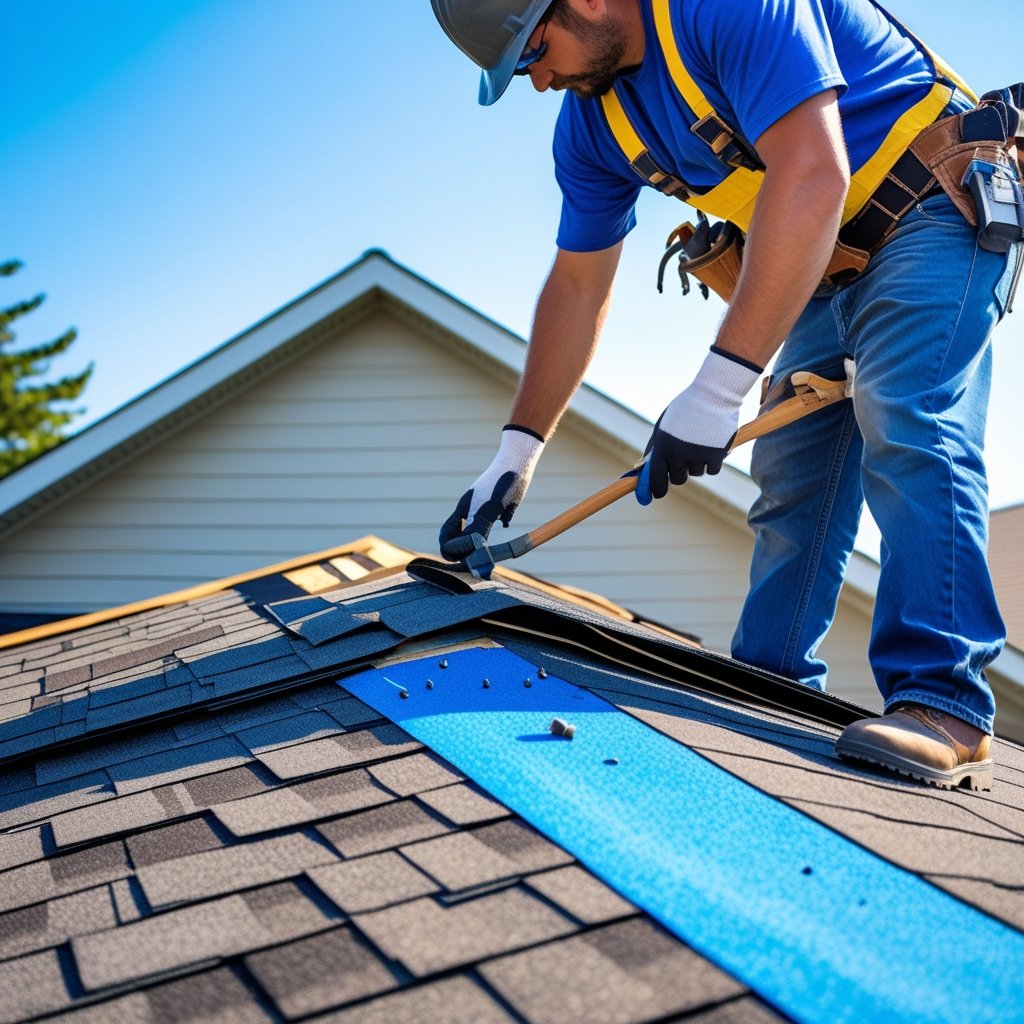When you notice damage on your roof, deciding whether to repair or patch it can be tricky. Small problems like a few missing shingles might only need patching, but bigger issues or an older roof may require a full repair or even replacement.
Knowing the difference can save you money and stress in the long run.
Patching is a quick fix for minor damage and can keep things from getting worse. Repairs are more thorough and help extend your roof’s life.
Understanding the pros and cons of both options will help you make the best choice for your home. You want a roof that protects you well without costing too much or causing extra headaches.
This guide will help you figure out when patching works and when you should consider a bigger repair.
Understanding Roof Repair and Patching
Knowing the difference between roof repair and patching can help you choose the right fix for your roof’s problems. Both stop leaks and damage, but they work differently and suit different situations.
What Is Roof Repair?
Roof repair means fixing specific problems on your roof, like broken or missing shingles, leaks, or damaged flashing. Repairs can cover small or large areas depending on what needs work.
Repairs last longer because they address the cause of the damage, not just the surface issue. For example, if a shingle is loose, a roofer will secure or replace it.
Roofers clean damaged spots and use quality materials to restore your roof’s protection. Repair is a good choice when damage is limited and the roof is in generally good condition.
What Is Roof Patching?
Roof patching is a quick, temporary way to fix small holes or leaks. This method fills or covers damaged areas with sealant, tar, or a patch of roofing material.
Patching works well for minor problems, like a small leak or a hole caused by debris. It costs less than repair but doesn’t last as long.
Patching prevents water damage until a full repair or replacement can be done. It’s not recommended for big or ongoing roof issues.
Key Differences Between Repair and Patching
FeatureRoof RepairRoof Patching PurposeFixes underlying issuesCovers small, surface problemsDurabilityLonger-lastingTemporaryCostModerate to highLowerScopeSmall or large damageMinor damageMethodReplace or restore materialsApply sealant or material patch
Choose repair when problems are more serious or long-lasting. Use patching only for quick, minor fixes that don’t need a full repair right now.
Pros and Cons of Roof Repair
Deciding whether to repair your roof means weighing what works best for your home and budget. Fixing small issues can save money and time.
Advantages of Roof Repair
Repairing your roof can be quick and less expensive than replacing it. You can fix small problems like a few missing shingles or minor leaks without major work.
This helps protect your home from water damage right away. Repairs allow you to extend the life of your roof, especially if it’s under 20 years old and mostly in good condition.
Repair work usually causes less disruption to your daily routine. It takes less time and fewer materials, which is good if you want to avoid a big project.
Disadvantages of Roof Repair
Repairs aren’t always a long-term fix. If your roof has major problems or is old, small repairs may keep failing and cost you more over time.
Fixing one part won’t solve bigger issues hidden underneath. Sometimes repairs can hide serious damage, so you might miss leaks or structural problems that get worse later.
That can put your home at risk and lead to expensive replacements down the road. If your roof is near or over 20 years old, repairs may be less effective.
At that point, replacement could be a better investment to avoid constant repairs and ensure your roof keeps protecting your home.
Pros and Cons of Roof Patching
Roof patching can be a quick and cost-effective fix for small roof problems. However, weigh the benefits and possible drawbacks before deciding if it’s the right choice for your home.
Advantages of Roof Patching
Roof patching is usually much cheaper than replacing the entire roof. If you have just a few damaged or missing shingles, patching can stop leaks and prevent water damage without a big expense.
It’s also faster to patch a roof, so there’s less disruption to your daily routine. A patch job can often be done in a day or two, saving you time compared to a full roof replacement.
Patching is a good option if your roof is fairly new or in good shape except for a small area. It can extend the life of your roof until a replacement becomes necessary.
Disadvantages of Roof Patching
Patching only fixes the damaged spots, not the whole roof. If your roof has many leaks or is more than 20 years old, patching might only delay the need for replacement.
A patch can wear out faster than a full replacement and may not last long in harsh weather. Over time, multiple patches can add up and cost more than doing the job right once.
Patching may also lower your home’s value. Potential buyers often see patched roofs as a sign of future problems, which might hurt resale chances.
If leaks return after patching, you might face repeated repairs, which can turn into a hassle and add extra costs.
When to Choose Roof Repair
Knowing when to fix your roof instead of replacing it can help you save money and avoid bigger problems later. Minor issues like small leaks or missing shingles are often best handled with a repair.
However, if damage is widespread, a repair might not be enough.
Best Scenarios for Repair
Roof repair works well when you have small, localized damage. This includes a few missing or broken shingles, minor leaks, or small patches of worn-out material.
If your roof is less than 20 years old and mostly in good shape, repairing the problem can extend its life. You should also consider repair when damage hasn’t spread to the roof decking or caused structural issues.
Quick repairs can prevent moisture from causing mold or wood rot. Repairing these small problems helps avoid expensive replacements.
Common Signs You Need Roof Repair
Look for missing, cracked, or curling shingles. These are clear signs that your roof needs attention.
You might notice water stains or little leaks inside your home, especially after rain. That means your roof isn’t keeping water out as it should.
Other signs include granules from shingles in gutters and moss growth on the roof. These indicate wear but don’t always mean replacement.
If you spot these, it’s best to schedule a professional inspection to see if repair is the right choice.
When to Choose Roof Patching
Roof patching is best when damage is limited and the roof still has many good years left. Knowing when patching will work can save you money and keep your roof safe.
Situations Ideal for Patching
Patching works well if your roof has a few missing or broken shingles. Small leaks or minor cracks in the roofing material can be fixed quickly with patching.
If your roof is under 20 years old and otherwise in good shape, patching can extend its life. Patching is also useful if only one section of the roof is damaged, such as damage from a fallen branch or storm debris.
Don’t patch if the problem covers a large area or if the roof is old and worn out.
Signs That Patching Is Sufficient
Look for isolated signs like a small leak in the attic or a few loose shingles on the roof. If the damage hasn’t spread and your roof feels solid, patching works.
Check if the roof patches well and no water leaks after repair. If your roof isn’t sagging, and there’s no major rot or mold, patching is enough.
You can monitor patched areas regularly to catch new problems early. If problems grow, then consider a full repair or replacement.
Cost Comparison: Roof Repair vs Patching
Knowing what you’ll spend on roof repair or patching helps you decide the best choice. Repairs often cost more upfront but can fix bigger problems.
Patching is cheaper but may only work for small, quick fixes.
Typical Costs of Roof Repair
Roof repairs can vary a lot depending on the size and type of damage. On average, you might pay $300 to $1,100 for common fixes like replacing shingles or fixing leaks.
If your roof is old or has multiple damaged spots, repairs can add up quickly. You need to consider labor, materials, and any hidden damage the contractor finds.
Repairs usually take more time because they might cover a larger area or involve extra work.
Typical Costs of Roof Patching
Patching fixes small problem areas. It’s a quicker solution, so it usually costs less.
For example, patching a few holes or missing shingles often runs between $150 and $400. Patching uses fewer materials and less labor.
It is best when the problem is small and isolated. Patching won’t stop long-term damage if the roof is old or has widespread issues.
Long-Term Costs and Value
Repairing your roof properly may cost more now but can save you money later. It helps prevent leaks and damage that get worse over time.
A well-done repair can extend your roof’s life. Patching might seem cheaper, but if the roof is too old or damaged, you may have to patch again soon.
Multiple patches can add up, leading you closer to a full replacement. When your roof is over 20 years old or has big problems, repairs or patches alone might not be enough to protect your home.
Impact on Roof Longevity
How you handle roof issues affects how long your roof will last. Fixing problems the right way can keep your roof strong for years.
Choosing between repair and patching changes the roof's durability and lifespan.
How Repair Affects Roof Lifespan
Repairing your roof can extend its life, especially if you catch the damage early. Fixing small leaks or replacing a few shingles stops water from getting inside and causing bigger problems.
Good repairs use quality materials and skilled work. If done well, repairs can add 5 to 10 years to your roof’s life.
Repairs won’t last forever if the roof is very old or has many issues. If your roof is over 20 years old or has widespread damage, repairs might only delay a needed replacement.
Regular maintenance and timely repairs keep your roof healthy but don’t replace the need for full roof care over time.
How Patching Impacts Roof Durability
Patching is a quick fix that covers small spots of damage. It can help stop leaks temporarily but usually doesn’t protect the whole roof well.
Patches often fail faster than repairs because they don’t address underlying problems like worn support or widespread material wear. A patch might last a few months to a couple of years before you need more work.
If your roof has lots of patches, it can weaken the overall structure. Patching is best for very minor issues, not for saving an old or badly damaged roof.
Using patches too much might cause you to spend more in the long run.
Aesthetic Considerations
How your roof looks after work is important because it affects your home's curb appeal and value. Some fixes blend in better, while others might stand out.
Knowing the differences can help you decide what fits your needs and budget.
Visual Differences After Repair
When you repair your roof, the goal is to make it look like new again. A proper repair replaces damaged shingles with new ones that match your existing roof.
This usually creates a neat fix that blends with the rest of your roof. If the repair matches well, color and texture differences are minimal.
You won’t see obvious patches or mismatched areas. This keeps your roof looking consistent from all angles.
If your roof is old or faded, even new shingles might stand out a bit. Repairs still usually look better than quick patches.
Appearance After Patching
Patching is a quick fix for small problems. It often involves placing new material over the damaged spot without replacing shingles.
Because of this, patches can be more noticeable. You might see differences in color, texture, or thickness where the patch is applied.
Patches can sometimes peek out or peel over time. This can make the roof look uneven or messy.
If your roof has many patches, the overall look can be less tidy. Patching is a short-term solution and may not satisfy you if appearance matters a lot.
AspectRepairPatching Blends with RoofUsually yesOften noMatch colorClose to originalMay be noticeably differentLongevity of LookLonger-lastingShort-termVisible seamsMinimalOften visible
DIY vs Professional Services
You can fix small roof problems yourself or call a professional. Doing it yourself might save money, but it takes time and some skill.
DIY pros:
- Saves money on labor costs
- Immediate action for minor issues
- You control the repair schedule
DIY cons:
- Risk of improper fixes
- Safety hazards on the roof
- Limited tools and materials
A professional roofer like Clear Choice Roofing brings experience and quality. Pros spot problems early and use the best materials for longer-lasting repairs.
Professional pros:
- Safer and faster work
- Access to quality materials
- Help with insurance claims and paperwork
Professional cons:
- Higher cost than DIY
- Scheduling and availability issues sometimes
If your roof is old or has big damage, let the pros handle it to avoid bigger problems. For small leaks or missing shingles, a simple DIY patch might work.
Clear Choice Roofing has served Austin for years with great reviews and top-rated service. If you want peace of mind and excellent craftsmanship, reaching out to them is a smart choice.
Environmental Considerations
Think about the environment when deciding between roof repair and patching. Repairing your roof instead of fully replacing it saves waste.
Repairing your roof means you throw away fewer materials. This reduces landfill use and lowers the impact on natural resources.
You keep most of your roofing materials while fixing only the damaged parts. Patching also saves materials but might not last as long.
If you patch an old or badly damaged roof, you may need more repairs later. This can create more waste over time.
If your roof is over 20 years old, replacement might be better. A new roof can use modern, eco-friendly materials that last longer and save energy.
These materials can reduce your home's heating and cooling costs.
Here’s a quick look at the environmental pros and cons:
OptionProsCons RepairLess waste, uses fewer materialsMay need more fixes laterPatchingSaves material short-termLess durable, may cause wasteReplacementNew, energy-efficient materialsMore waste from old roof
Weigh the damage and roof age before deciding. Professionals like Clear Choice Roofing in Austin can help you explore green options and make an eco-friendly choice.
Frequently Asked Questions
Understanding the pros and cons of patching versus repairing your roof can help you protect your home and save money. Knowing how long repairs last, when to replace a roof, and how repairs affect its lifespan are key to making the right choice.
What are the benefits of patching a roof instead of a full replacement?
Patching can fix small problems quickly and at a lower cost. It stops leaks and prevents further damage without needing to replace the entire roof.
This is a good option if the damage is limited and your roof is relatively new.
How long can a patched section of a roof last compared to a new roof?
A patched area usually lasts a few years if done properly. A new roof can last 20 years or more depending on materials and care.
Patches are temporary fixes while a new roof offers long-term protection.
What signs indicate that a roof needs more than just patching?
If you see many leaks, large damaged areas, or your roof is over 20 years old, patching might not be enough. Widespread damage means your roof may need full replacement to avoid bigger problems.
Does patching a roof affect its overall lifespan?
Patching can extend your roof’s life slightly, but it won’t restore the full lifespan. Repeated patching might delay replacement but will not make an old roof last as long as a new one.
Can patching a roof lead to more problems in the future?
Poor or temporary patching can cause leaks and other issues later. If damage is serious or widespread, patching may fail and lead to higher repair costs or emergency replacement.
What factors should be considered when deciding between roof repair and a full roof replacement?
Look at the roof’s age and the size of the damage. Compare repair costs with replacement costs.
Think about how long you plan to stay in your home. Consider the risk of needing repeated repairs.
Check the condition of the underlying roof structure.



